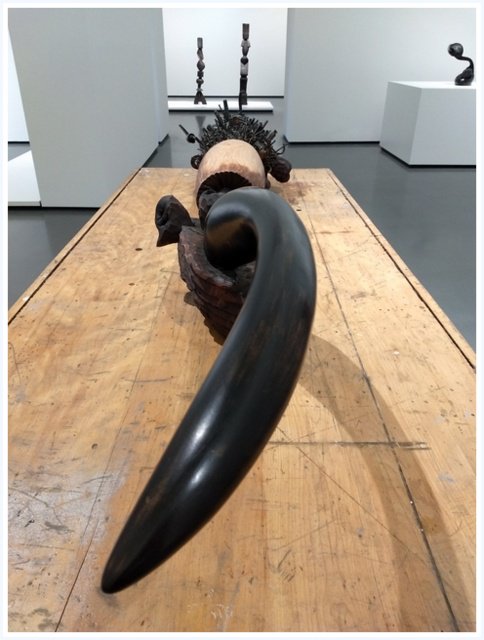[ad_1]
By J. K. Schmid, Special to the AFRO
Jack Whitten, the distinguished contemporary Black artist, premieres at the the Baltimore Museum of Art (BMA) this weekend.
“Odyssey: Jack Whitten Sculpture, 1963-2017” features 40 works of an artist whose career spanned five decades.
Part exhibition, part biography, the BMA display presents a uniquely physical encounter with the artist’s work and his life.

A years-long project of negotiation and curation culminates, in part, as a memorial. Jack Whitten died Jan. 20, 2018.
The Jack Whitten story, as told by the BMA, is one of a refugee and sojourner. Whitten was born in 1939 in Bessemer, Ala., deep in the Jim Crow South, to a family of artists; Whitten’s brother, Bill, is the designer of Michael Jackson’s signature crystal gloves and socks.
Whitten originally studied to become an Army doctor through the ROTC and Tuskegee Institute. It was there that Whitten was inspired by the polymath Dr. George Washington Carver, another artist.
Later, Whitten joined the burgeoning Civil Rights Movement. After hearing the Rev. Dr. Martin Luther King speak at the Montgomery Bus Boycott, Whitten joined marchers in Baton Rouge, La. When the backlash turned violent, Whitten took refuge in New Orleans until things cooled off.
Whitten eventually escaped the violence in the South and sought to make a break into the New York arts scene. Stifled by the rules of teachers and the conventions of critics, Whitten began travelling to Europe.
Rather than retreat to Paris, in the mode of the Harlem intelligentsia, Whitten instead went to Crete. Seeing samples of African carvings stateside, Whitten became seized by a dream: to carve something from a whole tree.
He found a prime specimen almost immediately, and his initial struggle was to find anyone that might give him permission to craft it. Crete was measurably more laid back than New York. His first set of tools were borrowed from a local carpenter, and he set to work.
In the ensuing years, Whitten developed into his signature style: a fusion of Black American, Cretan and African traditions. Crete, like Whitten’s work, is just about equidistant between Africa and Athens.
“Homage to Malcolm,” for example, combines multiple African traditions into one compelling piece. Like Malcolm X, the pan-Africanist and Black nationalist, combines traditions. In one portion of “Homage” burning is used to carve and treat a recess; in another, the practice of nailing is demonstrated, the work ends or begins with a long spine in the spirit of a headdress. Wholly asymmetrical, without an obvious beginning or end, the piece cannot be confronted head on, or in order, but only in its entirety.
“The Apollonian Sword” works with wood and marble, classically Greek materials. A white blade is set in black mulberry, then sealed with molten lead. This use of molten lead is the same method ancient Greeks used to anchor the bases of the columns in the Parthenon, which still stand today.
“The Afro American Thunderbolt” combines African and Cretan traditions with a copper-jacketed bolt of lightning. The symbol of Zeus’ power and protection is enhanced with the African spiritual practice of warding nailing.
As viewers proceed further, the works get more and more personal incorporating the debris and artifacts of Whitten’s personal life.
With more and more time in Crete, Whitten became a master fisherman. Fishing line, fish bones, and other aquatic motifs enter his work. Spearing octopus, his specialty, enters his work with the incorporation of tentacular imagery and the use of octopus and cuttlefish ink.
The exhibit concludes with Whitten’s parallel project: his portraiture. Eight of the “Black Monolith” series pay tribute to the likes of James Baldwin, W. E. B. DuBois and Ralph Ellison. Many include mosaic work learned in Crete.
Stephen Towns, 38, is currently on exhibit at the BMA; the curation is entitled “Stephen Towns: Rumination and a Reckoning.” He spoke about Whitten’s impact on him as a fellow artist.
“I enjoy the materiality of the work,” Towns told the AFRO. “Quilting and even my paintings are about sort of piecing things together. And when I’m making a square object, that you’re going to stand in front of, all I have to think about is a person standing in front of an object. But for someone like him, these sculptures, he has to think about the person’s total experience walking around the object. I think at some point, I’d like to be able explore the same things. Seeing the show has definitely inspired me.”
“Odyssey” opens to the public April 22 and will run through July 29.
[ad_2]
Source link


